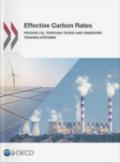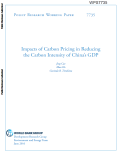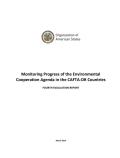

In contributing to global climate change mitigation efforts as agreed in Paris in 2015, China has set a target of reducing the carbon dioxide intensity of gross domestic product by 60-65 percent in 2030 compared with 2005 levels. Using a dynamic computable general equilibrium model of China, this study analyzes the economic and greenhouse gas impacts of meeting those targets through carbon pricing. The study finds that the trajectory of carbon prices to achieve the target depends on several factors, including how the carbon price changes over time and how carbon revenue is recycled to the economy. The study finds that carbon pricing that starts at a lower rate and gradually rises until it achieves the intensity target would be more efficient than a carbon price that remains constant over time. Using carbon revenue to cut existing distortionary taxes reduces the impact on the growth of gross domestic product relative to lump-sum redistribution. Recycling carbon revenue through subsidies to renewables and other low-carbon energy sources also can meet the targets, but the impact on the growth of gross domestic product is larger than with the other policies considered.

Since 2005, the United States has invested approximately US$ 87.2 million to fund the Central America-Dominican Republic-United States Free Trade Agreement (CAFTA-DR) environmental cooperation. This funding is helping CAFTA-DR countries advance in the following four programmatic areas: (A) Institutional Strengthening for Effective Implementation and Enforcement of Environmental Laws; (B) Biodiversity and Conservation; (C) Market-based Conservation; and (D) Improved Private Sector Performance.
In support of these areas, the Environmental Cooperation Agreement (ECA) (Article IV) requires that the Environmental Cooperation Commission (ECC) be responsible for examining and evaluating the cooperation activities under the Agreement. The ECA highlights as well that the ECC must also seek and consider input from relevant international organizations and other stakeholders regarding how best to ensure that it is accurately monitoring progress.
Armenia and Georgia are taking the climate change agenda seriously and contributing to efforts for mitigating global climate change through various ways, including preparation of low-carbon development strategies for their future economic growth. The improvement of energy efficiency is one of the key elements of the low-carbon development strategies. This study develops a methodology to estimate a marginal abatement cost curve for energy efficiency measures and applies it to the building sector in both countries. The study finds that among the various energy efficiency measures considered, the replacement of energy inefficient lightbulbs (incandescent lamps) with efficient lightbulbs is the most cost-effective measure in saving energy and reducing greenhouse gas emissions from the building sector. Most energy efficiency improvement options considered in the study would produce net economic benefits even if the value of reduced carbon is not taken into account.
This study explores how the proposed activities by the Congo Basin countries to reduce drivers of land emissions from deforestation and forest degradation (REDD+) could support the transition to a green economy and low carbon development future. By employing a content review and analysis of national REDD+ strategies and REDD+ readiness proposals submitted to the Forest Carbon Partnership Facility, the researchers found out that many of the proposed REDD+ activities by the Congo Basin countries including: climate smart agricultural practices and certification of large scale agricultural plantations; establishment of wood fuel energy plantations and improvement in energy efficiency; forests certification and implementation of the VPA-FLEGT; land use planning and zoning of mined sites; and the implementation of construction projects in low forested areas aligns with several green economy sectorial programmes of the Economic Community of Central African States (ECCAS).
